-
Get Cloud GPU Server - Register Now!
Toggle navigation
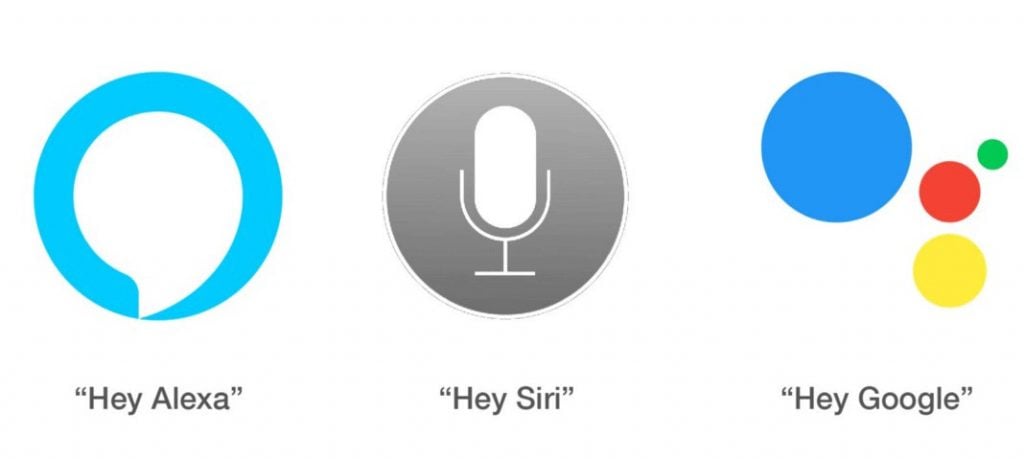
Siri, open my email box and look for any unread emails!
Alexa, open YouTube and play my favorite song!
Cortana, print this page for me!
Hey Google, what’s the weather today?
Besides, all of these statements commanding some tasks, the common thread of connection in all of them is, they all are AI-powered voice assistants. Siri, Alexa, Google Assistant, and Cortana are some of the names that people have recently become familiar with.
Having a personal assistant is like an ultimate luxury, somebody who listens to what you’re saying, anticipates your every need, and takes all the actions necessary.
Thanks to Artificial intelligence and machine learning, the splendor of owning a personal secretary is available to everyone, in the form of voice assistants.
A voice assistant takes your command through your voice. Also called voice bots, these artificial agents listen to your voice, to understand what you want, and then delivers the results.
In technical words, a voice assistant is a digital assistant that uses voice recognition, speech synthesis, and natural language processing (NLP) to provide service through a particular application in response to the voice command.
Let’s suppose you say, Ok Google, Call Mom!
Google Assistant will look for the contacts saved by the name, Mom, and will call her.
So, instead of, typing mom in your contact list, all you had to do was use your voice.
Google Assistant from Google, Siri from Apple, Alexa from Amazon, Cortana from Microsoft are all AI-based chatbots that let you use your voice as keyboard shortcuts. These chatbots provide you with a real-life human conversation, hence the popularity.
Even with only these handful scenarios, it is easy to understand why voice assistants are shaping up the hubs of connected homes and connected devices. The power of voice assistants is such that more and more brands are developing applications for various platforms, reflecting upon the needs of the customers.
Voice technology debuted long before Apple’s Siri was launched. In 1962, IBM presented a tool called Shoebox. It could perform mathematical functions, and recognize 16 spoken words ass well digits from 0-9. In the 1970s, Carnegie Mellon University created Harpy. It could recognize 1011 words.
In the 1990s, tech-giants like IBM, Apple, and others started working on voice tech. Apple began constructing speech recognition features into its Macintosh computers.
The mainstream voice assistants were launched first by Apple, named Siri, in October 2011.
The following image shows the release of the top voice assistants in the market.
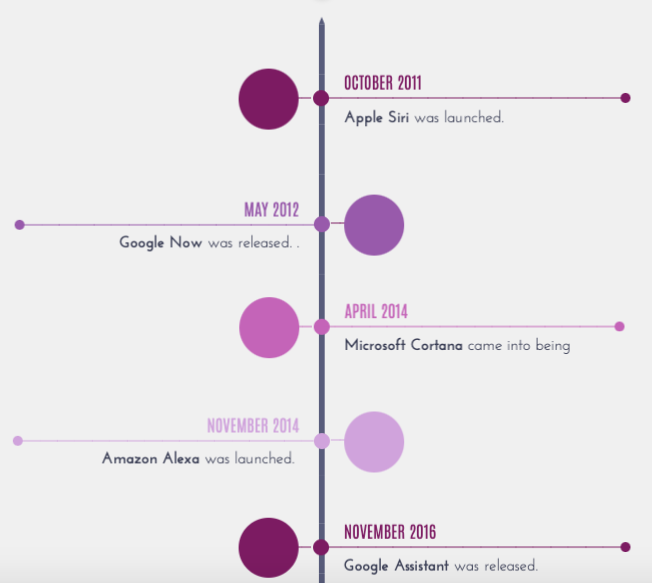
Given the amount of change that has happened the industry in recent years, voice assistants will assume more prominent tasks than telling you the weather or calling a person.
So, how many devices are connected with voice technology?
Let’s look at the stats!
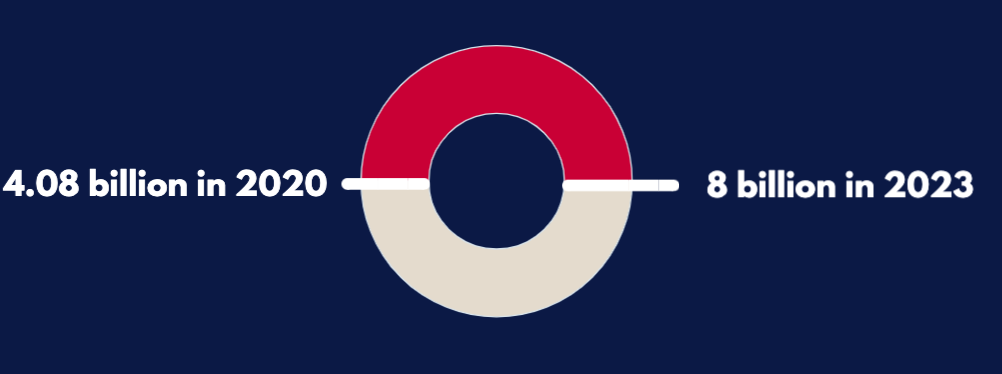
Voice assistants have become an important segment of the smart devices market. According to Statista, the number of digital voice assistants in use around the world is 4.08 billion in 2020. It will grow by almost 50%, to 8 billion, by 2023.
So, what’s causing this shift towards voice technology?
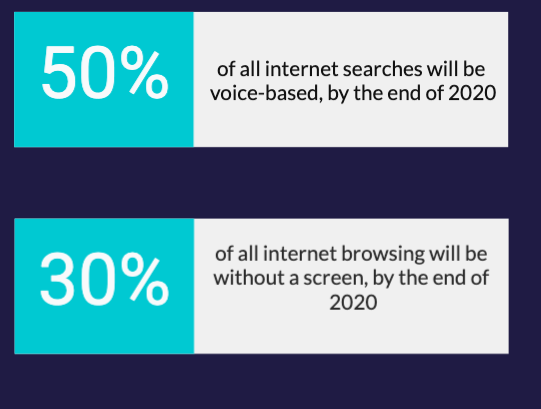
Voice assistants come with speed, efficiency, accuracy, and convenience for users.
The millennial generation has increased the overall awareness of the voice assistant. Young consumers from 18-24 years of age are rapidly adopting voice technology at a faster rate than their older counterparts. Furthermore, users from 25-49 years of age are the heavy consumers of this tech.
The digital AI chatbots are constantly being optimized for tech-savvy customers. Furthermore, with the increase in the adoption of smartphones and IoT enabled devices, voice assistants will become an integral component in every household.
So, which are the most popular voice assistants in the market?
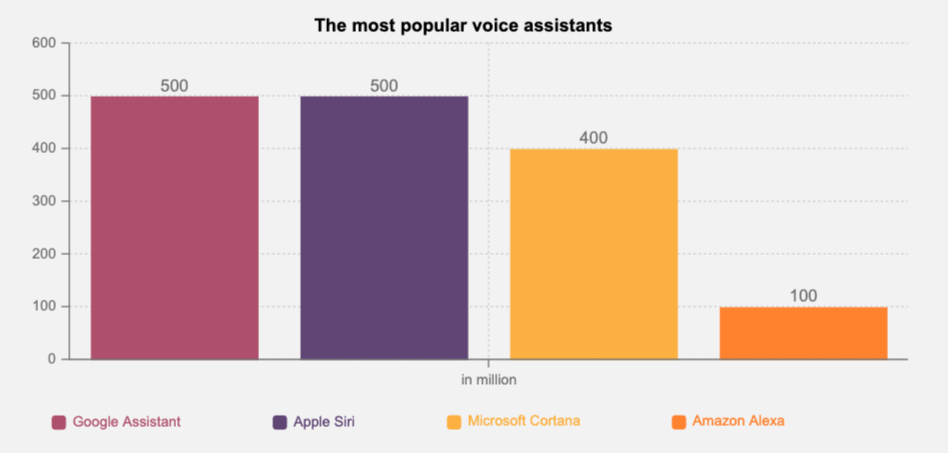
Google Assistant and Apple Siri cover 500 million devices, mainly because these are available in mobile phones and home speakers. Microsoft Cortana is included in personal computers and smartphones, however, Microsoft-powered mobile devices don’t have a prominent user base. Amazon Alexa is available in smart speakers only and that’s why it has the least number of devices covered. However, Alexa comes with a great API interface and is very much liked by its users.
Which devices are equipped with voice assistants?
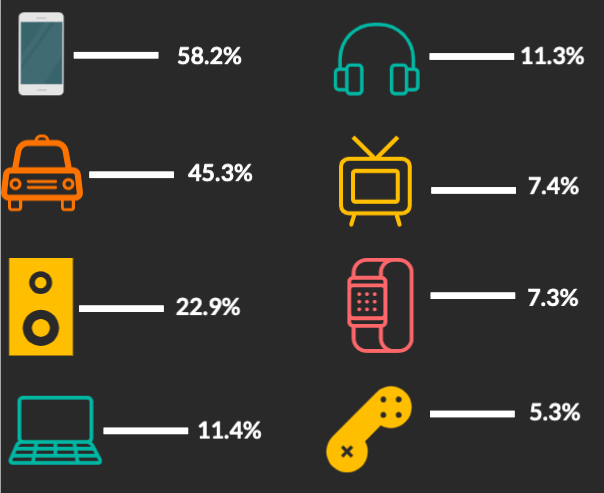
Voice assistants are mostly used in devices like smartphone (58.2%), in-car (45.3%), smart speakers (22.9%), computer (11.4%), headphones (11.3%), television (7.4%), smart watch (7.3%), and game consoles (5.3%).
What are voice assistants mostly used for?
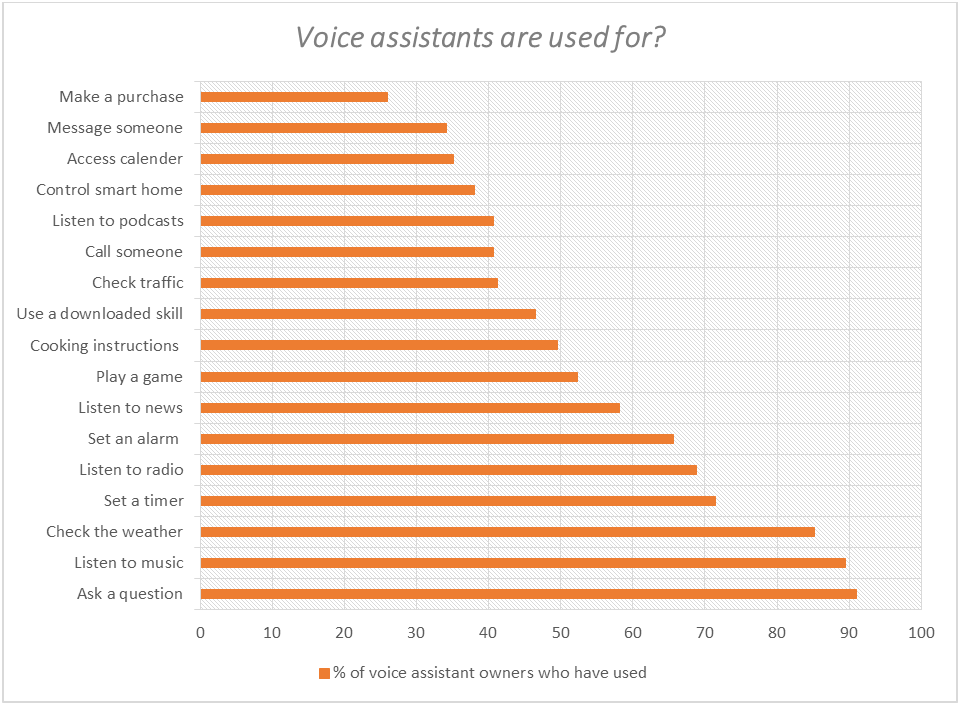
Voice assistants are mostly used for asking a question, listening to music, checking the weather, set an alarm or timer, listen to the radio, play a game, cooking instructions, checking traffic, etc.
For now, bulk consumers are using this medium to carry out basic functions only. Accessing activities like shopping or controlling other smart devices in the home is still untouched, and users are yet to examine them.
Many devices we use daily are powered with voice assistants. They are on our smartphones, smart speakers, television, cars, etc. Many mobile apps also use them. Furthermore, certain technology in retail, education, healthcare, and telecommunications, can also be operated by voices.
According to a survey, the penetration of voice assistants is growing at a multifold level. Its adoption is mainly contributed to factors like simplicity and accessibility. These features appeal to a bigger and more diverse audience, with each passing day.
According to a report, 52% of voice assistant users keep their devices in the living room or the dining room. At present, voice assistants are only being used in private settings, like at home or in a car. However, with the skyrocketing numbers, it will soon be used for complex operations like payments, shopping, accessing personal information, ordering food and much more.
But, how exactly are voice assistants reshaping our lives?
The first time Apple Siri was released, back in 2011, it didn’t have a human emotional quotient into it. Most people also said that Siri wasn’t able to answer any questions. To personalize voice assistants better, the voice applications offered open architecture platforms, APIs, and integration solutions and tools, to build customized applications called Skills. This is, what engineered a strong voice application ecosystem.
Businesses can use voice commands to work with virtual assistants in the office. Voice assistants boost productivity in the workplace. You can create calendars for appointments, read your emails, add tasks to project management apps, and do so much more using voice assistants. The openness of enterprise voice assistants allows businesses to use natural voice experiences while communicating with management departments like operations, HR, IT, etc. Voice search is key for businesses to watch out for. They need to strategize their marketing tactics keeping the future of voice search in mind.
For enterprises, enabling AI-chatbots offers customers a more personalized experience.
For users that shop online, voice chatbots can make them stay in the most conversational way possible.
Voice for marketers offers user profile management. Based on voice, a profile can be created for every user with their voice as the authentication source. This way, marketers can offer a more customized experience to each user. It facilitates the brand-customer relationship.
Moreover, companies will benefit a lot with consumer data categorized based on interests, devices, access location, purchase/search history, etc.
IoT and voice assistants can transform your living spaces as well. IoT helps in connecting all the devices in your house and voice assistants, will let you access any device, be it, computers or mobiles, without moving off from your couch.
If you ever wanted to talk with all your appliances like refrigerator, coffee machines, television, thermostats, washing machine, etc., now you really can!
With voice assistants enabled by AI and machine learning algorithms and IoT connecting all your devices, you can use your voice to control every equipment in your house. Some companies are already powering their machines with voice commands. For example, Whirlpool has made most of its appliances smart enough by enabling users to instruct the devices through voice, using Google Assistant or Alexa.
LED smart bulbs, automation appliances, lights, security cameras, smart kitchen, or thermostats, everything is being made voice compatible too.
It is normal for any new tech to suffer some setbacks in the market.
However, some of the issues mentioned in the image are genuine enough.
As technology progresses, so will the security and privacy aspect of voice assistants.
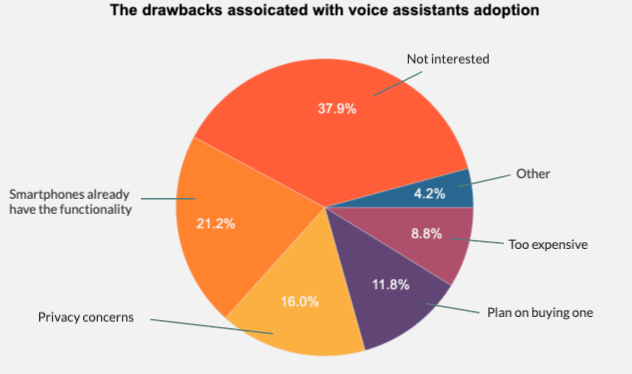
Some of the major reason as to why the adoption of voice assistants suffers from drawbacks include:
Privacy is very important, especially in smart speakers. Smart speakers are always listening. When you use your smartphone to access any app, the assistant is activated. It keeps on recording clips, which are then send to the server to process the audio and formulate a response. The real brains are not inside these speakers, it on a server, elsewhere. Some people question this aspect and, therefore, do not feel safe while using it.
Voice assistants are not always able to understand what you have to say. Therefore, they can’t respond to some questions accurately. This isn’t the mistake of the voice assistant, but because AI has not fed them with similar data.
People who search online for something, most of it comes in the form of answers and not the source of the information. It hampers the productivity and product image of smart voice assistants.
Although voice assistants communicate with the server using an encrypted connection, there are still chances of hacking and data security.
There was an issue when users complained about a weird laugh from Amazon Echo. The company responded saying, that Alexa heard words similar to laughing. This issue was later fixed.
In the case of smartphones, people need to be careful not to link doors and security cameras to voice searches. This can also let burglars to enter your house.
Without a doubt, the number of people using voice assistants will grow. As AI-bots will be made more smart and humane, users will be able to have more human-like conversations with assistants. Smart speakers are the most dominating segment of voice assistants. As the segment expands worldwide, they will be fed more data to understand the language, accent, dialects, slang, and nuances of each country.
Consumer awareness is on a rapid rise for this segment and there is no denying that voice is the future of enterprises, homes, businesses, hospitals, retail, education, and any other market. Brands need to take leverage of voice assistants for search, content, and commerce, to gain an edge in the competition.
In simple words, the dawn of voice assistants is here!